Fink, thieves legend
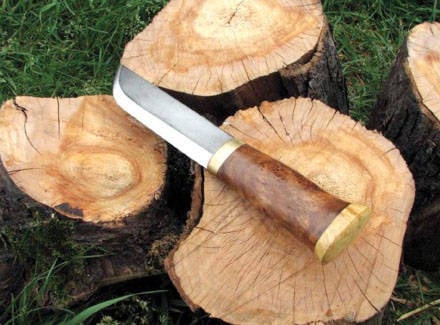 What would be the course of human stories without taming the fire, inventing the wheel, taming animals? In a number of fateful achievements, you can safely put the creation of a knife.
What would be the course of human stories without taming the fire, inventing the wheel, taming animals? In a number of fateful achievements, you can safely put the creation of a knife.The world's best-known short-bladed inconsistent weapons is a finnish knife. True, for people who are ignorant, this very word contains some kind of thug taste (in the form of a certain Vaska Krivoi with a golden fix and a “finale” in his pocket) and the threat of criminal liability. Meanwhile, we are talking about a brilliantly simple, convenient, “non-aggressive” knife, which has existed for almost a thousand years in almost unchanged form, without losing its popularity.
What is the "Finnish knife"? In his homeland, he is called “puukko” (puukko) from the word “puu” (tree), which sounds similar in all languages of the Finno-Ugric group: Mari and Udmurt “poo”, Yuraks “pa”, etc. That there is a "puukko" means a "knife with a wooden handle." It is also said that in the XII century in the Swedish regions of Scandinavia there was a knife called “pook”. Be that as it may, it has spread among the Finns, becoming it is their national knife, the everyday companion of people living in the forest and tundra.
By the way, it is very important - who where he lived and what he did, depending on this, and the knife became a weapon or a tool of labor. For example, in the Caucasus, where the whole story is marked by constant armed confrontation, the knife was pulled out and pulled out very easily; he even visually turned into a predatory-dangerous dagger, being now even a part of the national costumes of the region. But calm Finns knife was an ordinary tool, looking completely innocent. Often, both old and modern Finnish knives are distinguished by a blade that is shorter than a handle that can work well (cut something, make a broom for a bath), but it is difficult to fight. This, of course, primarily refers to household knives, but in other puukko the blade is often no more than a handle, i.e. its length is not more than the width of a man’s palm. He is a reliable assistant on the way, housework, hunting and fishing. Of course, for the one who owns him, as an extension of his own hand, he is also an effective weapon; without being a dagger, it can be used in battle, which has been successfully proven in practice. But a layman who, on the occasion, acquired a real puukko and decided to wave at them during street disassembly, risks serious injury: the knife has no guard, and an incorrectly executed blow can literally “go sideways” by the striker himself.
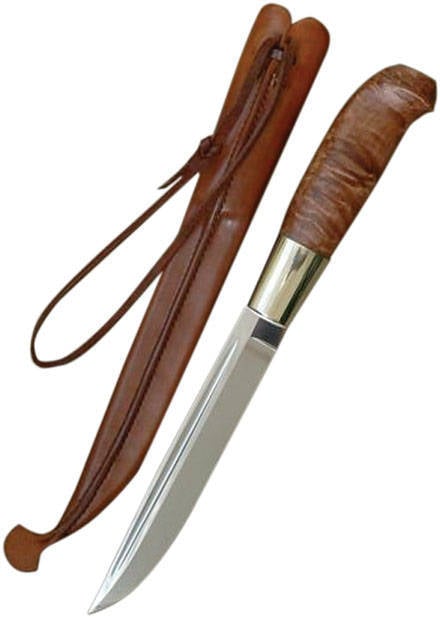 Since the 17th century, Finland has distinguished two types of national knives: the actual puukko and its northern variety, the heavy leuku, the Lapland, or the Sami knife, which the Finns themselves are sometimes called “Russian”. It is used by the Sami people (lapps), engaged in reindeer herding in Lapland. This is a typical tundra knife with a more massive blade than the knives of taiga hunters. They are easy to chop, and in the tundra it is quite possible to do without an ax when harvesting branches, stakes for yaranga, drywood for the fire. This is a close analogue of the Russian tundra knife. Its similarity with the traditional knives of northern peoples of Russia immediately catches the eye: a wide blade with straight butt and sloping transition from the blade to the tip; the handle is a rather unusual shape of wood or horn, almost round in cross section, without a front stop; rear support in the form of a mushroom thickening resembling the base of a deer antler. Kamus sheath (unmade skin of the deer's lower leg) or tanned leather; on them often the sheaths are sewn for a second, smaller knife or a special tool. The handle is always wider than the blade, with a wide blade it is very massive, but it still enters the sheath for most of its length, and the case goes without additional fasteners. Over the centuries, the leuku remained virtually unchanged; he, like the famous tundra "parinsky" knife, became popular among the northern peoples due to its specific qualities and special manufacturing technology.
Since the 17th century, Finland has distinguished two types of national knives: the actual puukko and its northern variety, the heavy leuku, the Lapland, or the Sami knife, which the Finns themselves are sometimes called “Russian”. It is used by the Sami people (lapps), engaged in reindeer herding in Lapland. This is a typical tundra knife with a more massive blade than the knives of taiga hunters. They are easy to chop, and in the tundra it is quite possible to do without an ax when harvesting branches, stakes for yaranga, drywood for the fire. This is a close analogue of the Russian tundra knife. Its similarity with the traditional knives of northern peoples of Russia immediately catches the eye: a wide blade with straight butt and sloping transition from the blade to the tip; the handle is a rather unusual shape of wood or horn, almost round in cross section, without a front stop; rear support in the form of a mushroom thickening resembling the base of a deer antler. Kamus sheath (unmade skin of the deer's lower leg) or tanned leather; on them often the sheaths are sewn for a second, smaller knife or a special tool. The handle is always wider than the blade, with a wide blade it is very massive, but it still enters the sheath for most of its length, and the case goes without additional fasteners. Over the centuries, the leuku remained virtually unchanged; he, like the famous tundra "parinsky" knife, became popular among the northern peoples due to its specific qualities and special manufacturing technology.The blade - the main part of the knife, which work or strike, is a specially treated metal strip. The most important thing in production is the manufacture of the blade; The key issue is the material from which it is made, because the cutting properties, strength and durability of sharpness depend on it.
According to rumors, before the Finnish masters made their puukko from old worn braids. Mild steel, plastic, amenable to cold forging, goes to the braid (the braid is grinding, beating, “delaying” its sting). So, they took a package of blades (i.e. a set of layers of metal with slightly different qualities), repeatedly heated and forged it, eventually obtaining an outwardly monolithic bar of laminated steel, internally similar to a sandwich made from a material of different qualities. In artisanal conditions, the real master as a blank sometimes used a strip of metal with already formed hardness parameters (spring, file, bearing holder), and the knife was obtained as needed. Now Finnish puukko are made from the best high-carbon steel grades (1,2% carbon), usually with alloying additives: nickel for rust protection; chromium for wear resistance, etc .; cheaper metal brands (0,6 – 0,8% carbon) go for inexpensive mass series knives. The hardness of the blades of the Finnish puukko fluctuates within 58 – 62 units on the Rockwell scale; In the course of a large number of fake low-quality steel knives with a hardness below 55 units.
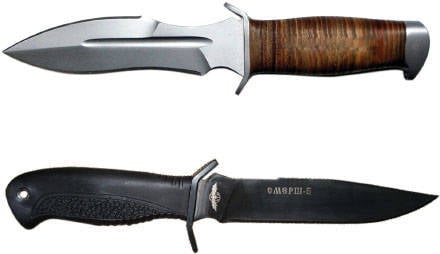 The Finnish knife has the following parameters: in a traditional village (working) puukko blade length did not exceed 100 mm, now for a mass (mostly foreign) consumer the blade is made quite long (150 mm). It is narrow in puukko (10 – 15 mm); its thickness is a bit unusual: the butt on the handle may be even thicker than 5 mm, thinning down and gradually turning into a blade; puukko - a sort of burly-boletus. The shape of the blade is proportional, it is usually simple: a straight or slightly falling butt (“drop point”), a long segment of a straight blade, a convex smooth transition from the blade to the tip. Sharpening is usually a wedge, although a saber has recently been used (a wedge with a supply). Now, the samples are made on the blades, which non-specialists call blood drains, attributing to this knife extraordinary destructive properties. In fact, it does not affect the severity of the injury, but provides additional blade stiffness and resistance to bending.
The Finnish knife has the following parameters: in a traditional village (working) puukko blade length did not exceed 100 mm, now for a mass (mostly foreign) consumer the blade is made quite long (150 mm). It is narrow in puukko (10 – 15 mm); its thickness is a bit unusual: the butt on the handle may be even thicker than 5 mm, thinning down and gradually turning into a blade; puukko - a sort of burly-boletus. The shape of the blade is proportional, it is usually simple: a straight or slightly falling butt (“drop point”), a long segment of a straight blade, a convex smooth transition from the blade to the tip. Sharpening is usually a wedge, although a saber has recently been used (a wedge with a supply). Now, the samples are made on the blades, which non-specialists call blood drains, attributing to this knife extraordinary destructive properties. In fact, it does not affect the severity of the injury, but provides additional blade stiffness and resistance to bending.Beginning in 1880, in rare cases, the blades were decorated with ornaments (for example, in the knife presented to the Russian Tsar); in modern knives on the blade is almost always the mark of the manufacturer or brand, but no more.
The handle of a real puukko cannot be confused with anything: it almost always has a round, less often slightly flattened barrel shape. Smoothly moving to the pommel and the blade, it seems inconvenient, and it looks like it will slip out of the hand. But it only seems: taking a knife in the palm, you feel how he is catchy. This seemingly primitive, but in practice for centuries, the worked-out form is extremely ergonomic; during long-term work, the brush from this “barrel” is much less tired than from fashioned knives with recesses under the fingers on the handle, because everyone has different hands, and “just for taste” products are something like an average jacket. A puukko in the palm of your hand narrow or wide, with the grip of direct or reverse will always find its place; in the winter they work without even taking off their mittens.
The “warm” handle of the knife is most often made of hardwood (Karelian birch, willow root, mountain ash) and is mounted on a black horseback method without rivets / screws. In puukko fishing, a skilled craftsman selects the ratio of the weight of the blade and the hilt so that, even after falling into the water, the knife does not sink, but sticks out in the water with a float. In addition, the handles are made from the horns of a deer, an elk, because these durable materials in Finland are not deficient. Waxed leather or birch bark handles are beautiful; the plates of the material are strung on the black (the bark has fibers perpendicular to each other), this set is tightly compressed, tightened with the upper and lower metal washer, and after that the handle is given the required shape.
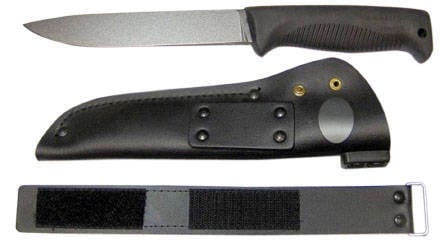 Not so long ago, for the manufacture of knives of gift and improved execution, they began to take exotic woods, coconut, ebonite, plastic, as well as brass and aluminum, from which the forgings are made: sleeve of the front part of the handle, pommel, rings (for the “old” puukko there is no bindings). The handle sometimes engrave, put an ornament, but it is not made entirely of metal, because the puukko is a northerner, try to take up the metal in the bitter cold. In addition, a metal handle slips out of wet hands easily.
Not so long ago, for the manufacture of knives of gift and improved execution, they began to take exotic woods, coconut, ebonite, plastic, as well as brass and aluminum, from which the forgings are made: sleeve of the front part of the handle, pommel, rings (for the “old” puukko there is no bindings). The handle sometimes engrave, put an ornament, but it is not made entirely of metal, because the puukko is a northerner, try to take up the metal in the bitter cold. In addition, a metal handle slips out of wet hands easily.The dimensions of the blade are very different, but the handle is always noticeably wider than it, which is connected with the unusual way of knife placement for Europe. For the convenience of taking out a puukko, almost “with the head” recessed in the sheath, the tops of the handles traditionally have a mushroom-shaped thickening or bend, often in the form of a stylized horse or dog head.
This is a very general description, since only the basic models of traditional Finnish knives exist for more than ten; the shape of blades and handles even from one master constantly varies; how many craftsmen - so many knives, and even more. In this case, some kind of its own shape of the whole knife and its elements is characteristic for each region and circle of users; for example, the so-called "female" knives have a very short blade and a wooden handle-pig. The emblem of Finland is often depicted on the hilt of factory puukko.
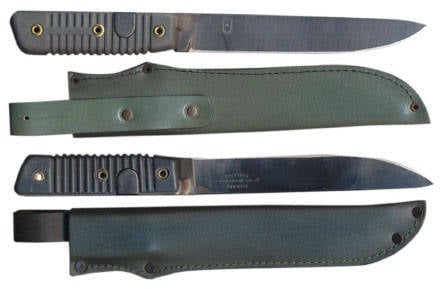 The sheath for puukko in the XIX century was rare, the knife was carried in a birch bark case; today they have become its integral and sometimes the only part visible from the outside, whose role is not limited to a decorative function. They are of several types, however, everyone reliably holds the knife, and is easily recognizable by a characteristic feature: the puukko is drowned in them almost entirely, by the top, and it should not be fixed in any additional way (strap, clasp, etc.); he will not fall out of the correctly stitched scabbard, even if he stands on his head. Fixation occurs due to the dense coverage of the mouth of the sheath of the expanding part of the handle. In addition, the strap or chain on which the puukko is suspended from the belt is attached to the top of the scabbard so that the center of gravity is greatly shifted down and the knife will never be in the down position, which means it will not fall out. In addition, the design of the sheath may include liners made of wood or bark, which fix the blade and protect the skin from cuts. If necessary, the knife is in the hand without delay, because it is removed without any effort; It is very comfortable in the bitter cold; Puukko is ideal for severe northern conditions. In combat conditions, it is very valuable that it can be extracted not only quickly, but also silently.
The sheath for puukko in the XIX century was rare, the knife was carried in a birch bark case; today they have become its integral and sometimes the only part visible from the outside, whose role is not limited to a decorative function. They are of several types, however, everyone reliably holds the knife, and is easily recognizable by a characteristic feature: the puukko is drowned in them almost entirely, by the top, and it should not be fixed in any additional way (strap, clasp, etc.); he will not fall out of the correctly stitched scabbard, even if he stands on his head. Fixation occurs due to the dense coverage of the mouth of the sheath of the expanding part of the handle. In addition, the strap or chain on which the puukko is suspended from the belt is attached to the top of the scabbard so that the center of gravity is greatly shifted down and the knife will never be in the down position, which means it will not fall out. In addition, the design of the sheath may include liners made of wood or bark, which fix the blade and protect the skin from cuts. If necessary, the knife is in the hand without delay, because it is removed without any effort; It is very comfortable in the bitter cold; Puukko is ideal for severe northern conditions. In combat conditions, it is very valuable that it can be extracted not only quickly, but also silently.The sheaths of leuku and puukko sometimes contain an additional compartment for a second, small knife (“yunki”), similar in shape to a large one. The present sheath is sewn most often from a whole piece of camus; The classic version is considered to be without a single metal rivet. The outer seam is laid differently than with traditional Russian knives - not from the blade, but from the back side, in the middle of the blade plane. The front side is decorated with an embossed pattern, national pattern; from the 19th century, the color of the scabbard in black or red color came into fashion, the fastening of engraved brass plates on them. And the knife handle is sometimes painted red with black transverse stripes; sometimes for souvenir knives, scabbards are made of Karelian birch and leather - the blade enters the wooden part, and the handle - into the leather cuff attached to it.
Previously, the sheath was hung from the belt at the two ends, carrying it parallel to the ground, then one strap (or chain) became longer, and when walking the knife swayed freely, drawing the attention of others to itself and its owner. Now, a sheath in a sheath is hung from one leather loop and worn perpendicular to the ground.
Finns treat making knives creatively. For example, in the works of Yarmo Hakkarainen from the village of Keyulie a reminder of this case was recorded: sometime in the 12th century, a Catholic bishop came to the house of the peasant Lally without an invitation, took all the winter supplies and insulted his master's wife. The peasant slaughtered him. Being very proud of the act of their ancestor, the Finns erected a monument to him, wrote books for children about him, and the master, in memory of this, makes his scabbard in the form of a headdress of an arrogant Catholic hierarch.
The Finnish knife has a “relative”: a traditional northern Parensky knife, made by hand in the Koryak village of Guy in Kamchatka. Since ancient times, the northern peoples forged knives in a special way, using iron and steel of various grades and obtaining a material called laminated steel; so, the parenist's knife has such a feature as the different hardness of the butt and blade of the blade. Nowadays, this technology is largely lost.
The Finn has another very respectable, though now almost forgotten, purely Russian relative - the “zaspozhnik”, worn behind the bootleg of the legendary 12th-century combat knife. He was an indispensable element of the equestrian guards' armament, and during the excavations of burials he is found where he is supposed to be - in the boot of a buried warrior. The blade of this relatively long, “stinging” weapon (total length 250 – 300 mm, blade 150 mm, thickness of the butt 5 mm) often went expensive bulat, which indicates that it was a serious thing, “the last argument” in the fight. There is an opinion that just in time, puukko originated from it (at least in Norway it is still called the “Russian knife”).
On the example of Finnish knives, it is clearly seen that a similar climate, natural conditions and way of life generate similar household items; It is not surprising that the Scandinavian knives have so much in common with the Yakut, Chukchi, Koryak and Nenets knives, although the nations themselves are divided by thousands of kilometers, and have no common history.
Finnish knife in the war
Puukko has long been known as a fighting knife. In the USSR, attention to it increased during the “winter war” of 1939 / 1940. In the Finnish units that fought on the Karelian Isthmus, the “Lynx” knife, mass-produced from 1879, was popular. Its total length is 260 mm. A blade with a length of 145 – 160 mm, a width of 18 – 20 mm and a thickness of 3 mm has small valleys / ribs to increase rigidity. The barely noticeable bevel in the front part of the blade gives the knife a predatory look. With a relatively small size, it is well fixed in the sheath, goes silently and is very convenient for fighting in the north; not having sharply protruding parts that inhibit penetration through thick winter clothing, easily enters the body when struck from top to bottom. It is ground to a razor sharpness, and it is equally convenient for them to cut bread and take down the sentry. A handle made of wood, usually Karelian birch, in the front is bound with a metal forging. There are no guards, but this is only a plus if the fighter is trained in the technique of combat work, which is characteristic of the Finca. With the right grip, the characteristic fungus in the back part fixes the hand not worse than the guard, but it hinders much less. The knife weighs only 100 g (with 140 g sheath), which, in combination with dimensions, makes it a very maneuverable weapon. It became the basis of Soviet combat knives, for example, HP-40 INP-43 famous for professional knives “Scout knives” NKVD - a variety of knives with bevel oblique and S-shaped guard. Variants of these knives are still in service with the countries of the former Warsaw Pact, such as Poland. Now, according to this same ideology, a new combat knife, the “Punisher”, has been developed.
Now in service with the Finnish army is the M-95 knife of the famous knife company Fiskars. With a total length of 280 mm, it has a massive blade (length 150 mm, width 23 mm, thickness 5 mm) with high rigidity; sharpening one-sided in the form of a wedge from the butt. On the blade with a dark antireflection coating there is a stamp with the name of the author, the patent number and the manufacturer's code. In the front part of the handle of semi-rigid black rubber there is a protrusion for supporting the arm - and the knife does not slide even in a wet hand, it does not stuff the arm. It weighs 200 g, which makes it possible to strike them with chopping blows, especially since the rubber handle perfectly absorbs recoil. M-95 is in service with the Swedish "special forces". As a bayonet for the "Valmet" machine gun (the "grandson" of the Russian AK-47), the Finns also took something like a classic Finn, and, according to foreign experts, one of best bayonet knives produced in the West.
Criminal option
Small dimensions, low weight and high fighting qualities of the Finnish knife attracted the attention of the criminal world. In Russia, all combat knives were called “a lesson” by Finn, except for throwing (“feather”), which was fixed in the Criminal Code and in thieves' folklore. For such "clients", knives with a metal cross-shaped front stop were usually made. The composite plastic handle has been telling a lot to a knowledgeable person about the owner of the knife. The back combat stop made of metal, leather sheath, covering only the blade, with additional fasteners that protect the knife from falling out - all of the above does not happen in a real puukko, which by police standards sometimes is not a weapon at all: it has no front stops, and the length of the blade may be less than 90 mm.
Knife for the king
Over time, puukko somewhat changed in the course of time, acquiring decorating elements. Making a decent knife requires the talent of a blacksmith, a jeweler, a tanner and a joiner; This Finns studied 150 years ago on the best English and Swedish manufactories. It is produced in Finland by numerous private craftsmen and small firms everywhere, but some regions, such as Pohjanmaa, especially the Kauhava region, are marked by this: after World War II, 26 of 30 of the largest Finnish producers of puukko were located here. To this day, the most expensive knives are made by hand, however, their industrial production has a long tradition.
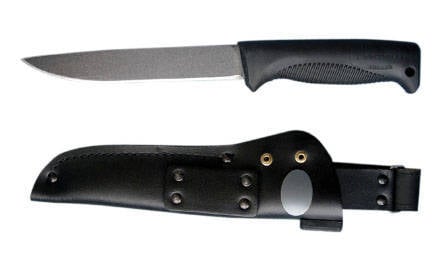 So, the famous kauhava-puukko knives are made in a factory founded in 1879 by the master of Iisakka Järvenpää. Almost without funds, having only a passionate desire to make beautiful knives, while learning how to forge and quench steel, the twenty-year-old boy alone went to work in his close barn. The creator of the new, artistically decorated puukko, he first began to pick up birch bark handles, inlay them with copper and silver, decorate the sheath with bronze and brass. In 1888, he made a knife for the heir to the Russian throne, Nikolai Alexandrovich; since 1890, 10 has already worked with him, and in 1894, he made the second knife, now for Emperor Nicholas II, which was testified to by the highest credentials. In 1922, more than 25 craftsmen worked in the factory; Today it is the largest production in Finland, producing only Finnish knives. In total, about 150 firms and private owners, one way or another connected with the production of puukko, entered the history of Kauhava. The second largest knife maker, Marttiini, focuses on the traditional design of Finnish knives.
So, the famous kauhava-puukko knives are made in a factory founded in 1879 by the master of Iisakka Järvenpää. Almost without funds, having only a passionate desire to make beautiful knives, while learning how to forge and quench steel, the twenty-year-old boy alone went to work in his close barn. The creator of the new, artistically decorated puukko, he first began to pick up birch bark handles, inlay them with copper and silver, decorate the sheath with bronze and brass. In 1888, he made a knife for the heir to the Russian throne, Nikolai Alexandrovich; since 1890, 10 has already worked with him, and in 1894, he made the second knife, now for Emperor Nicholas II, which was testified to by the highest credentials. In 1922, more than 25 craftsmen worked in the factory; Today it is the largest production in Finland, producing only Finnish knives. In total, about 150 firms and private owners, one way or another connected with the production of puukko, entered the history of Kauhava. The second largest knife maker, Marttiini, focuses on the traditional design of Finnish knives.Despite its age, the Finnish knife was able to prove its usefulness in our technologized world.
Information